In Thinktiv’s recent article “Legacy Management Consulting is Dead. Why Anti-Consulting Will Win in the Age of AI,” we wrote about how the incrementalism, margin enhancement focus, and one-size-fits-all market perspectives of legacy management consultants are poorly suited for delivering value creation in the Age of AI. Particularly for software and software-enabled services businesses—whose market share will be threatened by new, AI-centric competitors—a new “Anti-Consulting” strategy model for value creation is required to minimize revenue erosion risk, accelerate sustainable growth, and pave new paths to category leadership in an AI-first market environment.
Introduction
This piece lists eight steps your management team and board can use to take stock of where you currently stand and to begin navigating a path toward an AI-first value creation strategy. Use this piece as an initial checklist tool to gather feedback and build consensus across the team, to frame a valuable strategy discussion at your next Board meeting, or to simply start thinking like an Anti-Consultant. When it comes to aligning to an AI-first mindset, the time to start is now.
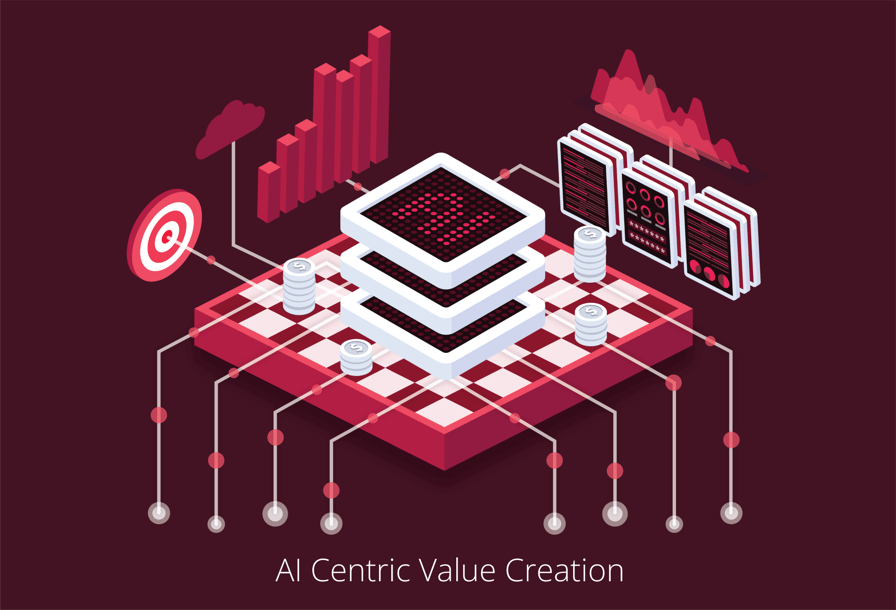
The Eight Steps Toward AI-Centric Value Creation
STEP 1
Come to terms with your AI commercial risk and your current readiness to compete.
Before you can make meaningful progress on your AI value creation journey, you must honestly weigh both the commercial risks that increasingly powerful AI poses to your business and your progress to date on the path to an AI-first future.
Things to Consider
- What frameworks can you use for assessing your product's maturity and weighing current competitive threats through the lens of AI?
- How do your current product/service offerings and product roadmap align to those AI maturity frameworks?
- How do secular trends related to AI (e.g. labor displacement) potentially threaten your business model?
- How does AI threaten your service differentiation and knowledge/expertise advantage?
- Which of your current or planned software products could be disrupted by new AI-native user experiences?
- What risks does AI pose to your proprietary data assets?
- How much of your overall revenue is exposed to this risk, and over what time period?
AI Maturity Model for Products and Roadmaps
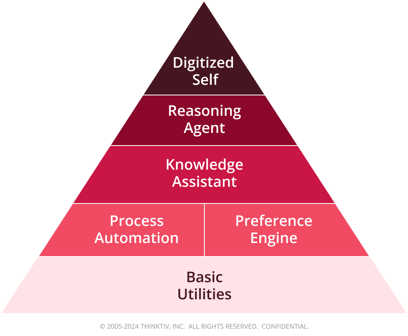
STEP 2
Walk the path toward AI-centric product strategy practices.
In an AI-centric world, the boundaries between product, AI, and data disappear, and an organization’s ability to tightly integrate them will either accelerate market leadership or multiply existential risk exposure.
Things to Consider
- What happens when data and AI practices are kept siloed from or adjacent to the core product lifecycle?
- What is the order of operations when defining an AI-centric product strategy?
- How should you determine which customer journey use cases are the most valuable to enrich with AI capabilities?
- How do you move past GenAI “experiments” into a repeatable, AI-first product management lifecycle?
- What does “best” look like when it comes to executing an AI-centric product strategy model?
Converge Product, AI, and Data Into a Single Integrated Practice
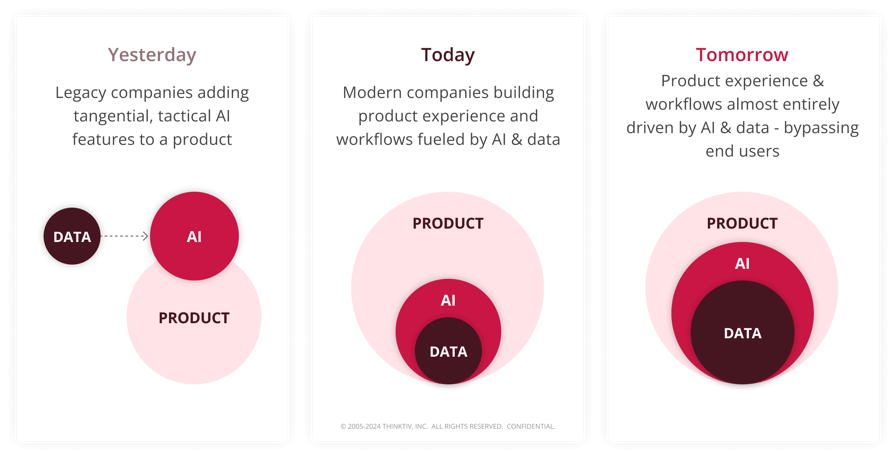
STEP 3
Identify and align your most valuable data assets.
In an AI-first market ecosystem, data assets become the essential driver of product differentiation and enterprise value.
Things to Consider
- What data assets does your business leverage and/or accumulate when customers engage with your products and services?
- Which of those data assets are proprietary and owned by your business? Proprietary and owned by your customers? Non-proprietary? Licensed from a third party?
- How does that data play a role at different stages of your customers’ product journey and user experience?
- Which data is best aligned to fueling prescriptive intelligence or smart recommendations within the daily workflows of your end users?
- What data assets could be leveraged in tandem to create an asset of greater value?
- What data gaps can we fill to multiply contextual value in the product?
Identify and Align Your Most Valuable Data Assets
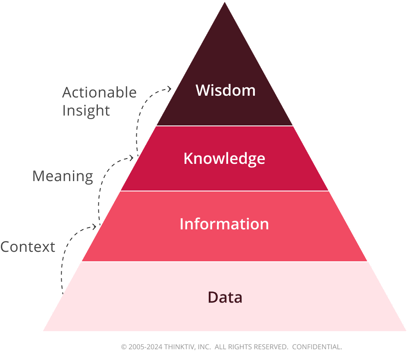
STEP 4
Embrace AI-centric UX transformation.
As AI—and particularly Generative AI paradigms—proliferate into product roadmaps, end-user product experiences will become increasingly economical and will move into the realm of automated, personalized answers. This will ultimately render legacy workflow-driven UX paradigms obsolete.
Things to Consider
- Which layers of your current UX should be stripped away in favor of highly economical, adaptive engagement with end users?
- How should we prioritize the reallocation of your product UX “real estate” away from labor-intensive workflow screens and toward GenAI-first user engagement?
- How should Voice of Customer UX research be invoked as you cede control of your product and data experience to end users?
- What components of your product’s value proposition could move “beyond end-users” and toward direct machine-to-machine interactions?
STEP 5
Architect data “flywheels” for category leadership and accelerated revenue growth.
The most successful AI-centric platform companies center their growth strategy around a flywheel of their data assets and AI-powered experiences.
Things to Consider
- What is your potential data asset flywheel, and how could it compound the value of your products in an AI-first market environment?
- How can you shift to an ecosystem view of your product and customer journey, so that you can create a holistic map of stakeholders, use cases, and touchpoints for value delivery and data capture?
- What new touchpoints can you architect to expand the breadth and depth of our data assets?
- How can your data be used to create differentiated AI models that feed increased value back into our stakeholder user experiences in a recurring loop?
- How should you align your product management practice and product strategy so that it is centered around your data flywheel?
Architecting Data Flywheels for AI-Powered User Experiences
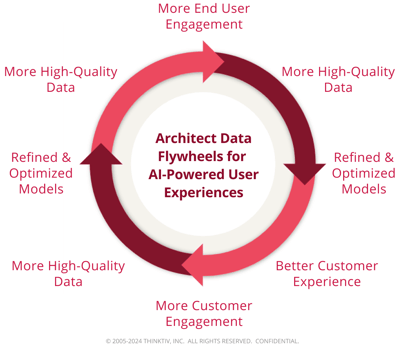
STEP 6
Evolve organizational design for AI product leadership.
As you construct an AI-centric product strategy practice that tightly integrates product, data, and AI, your organizational design and role composition must evolve in parallel.
Things to Consider
- Which organizational structures best support an AI-centric product strategy practice?
- What new roles must be defined and staffed to ensure strategic alignment between data operations, AI operations, product management operations, and engineering?
- Should you have a Chief AI Officer? A Chief Data Officer? What do those job descriptions encompass?
- Where does UX research and design fit into the organizational hierarchy as you shift to an AI-first paradigm?
- How should you orient the rest of our organization to this shift in strategic focus?
STEP 7
Align your commercial strategy for maximum growth and valuation impact.
Central to an Anti-Consultant view is the need for deep integration between new product/roadmap innovation, the voice of the customer/buyer, and a business’s commercial architecture. New AI-centric product experiences and data flywheels matter only to the degree that they are perceived as a leap in value by end users, contained within a strategic market narrative, targeted at the right ICPs, and packaged to capture substantial economic value from customers.
Things to Consider
- How can your AI-centric product roadmap support more strategic market positioning and a category leadership narrative?
- How should you refactor your solution packaging and pricing architecture to capture full value for your AI-centric capabilities?
- How can new data assets and stakeholder product touchpoints multiply your addressable users and TAM within accounts?
- How can you leverage a buyer perspective to align roadmap prioritization, perceived value, and enhancements to the existing business model?
- How should your account management and customer revenue expansion motions evolve as your AI-centric solutions are commercialized?
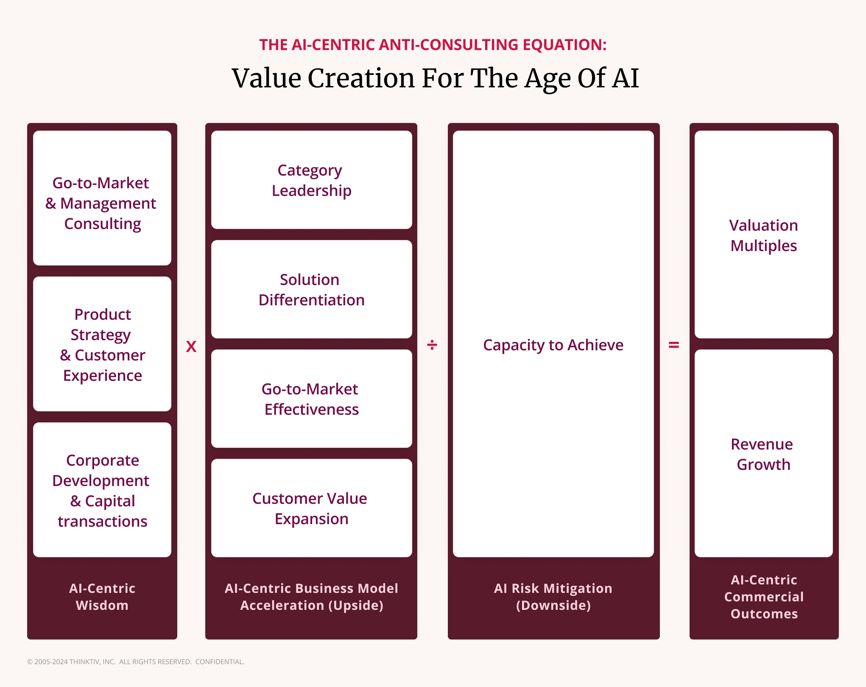
STEP 8
Expand to an AI ecosystem mindset in Corporate Development.
In an AI-centric market environment, traditional views of corporate development and M&A must expand to include data as a primary driver of strategic value, accelerated growth, and enduring market advantage.
Things to Consider
- How should you recast the market ecosystems you track when considering potential partnerships, acquisition targets, or buy-side acquirers?
- What frameworks can you use to evaluate strategic alignment through an AI-centric lens?
- What data-centric acquisitions could you target that enable you to feed your growth flywheel and expand market share more quickly?
- How can you more tightly align your corporate development team and AI-centric product practice to ensure you’re maximizing the value of your own proprietary data?
- Should you reconsider how you are exposing your data assets to third parties within your established commercial partnerships?
AI-Centric Models for Corporate Development Ecosystem Mapping
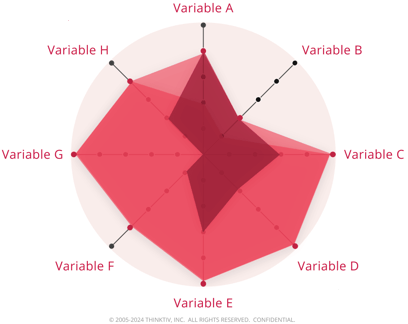
If you feel like your organization is spinning its wheels when it comes to AI, it’s time to take more forceful, holistic action to build a winning AI-centric Value Creation strategy. For both emerging growth software-driven businesses and the world’s largest enterprises, Thinktiv’s Business Value Architecture (BVA) programs deliver integrated value creation strategies that address the questions above, enable huge leaps forward in aggressive time frames, and align management teams and boards on a path toward superior capitalization outcomes.
Meanwhile, in upcoming posts, we’ll dig into further detail on each of these AI-centric Value Creation components and welcome your thoughts and feedback.
Click here to arrange a time to discuss how the BVA fits into your strategic planning.